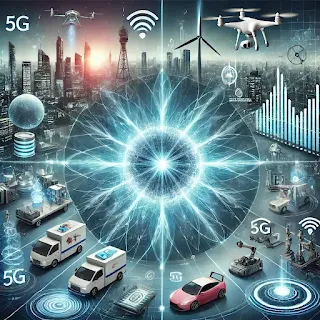In the rapidly evolving landscape of technology, electromagnetic innovations are poised to become one of the most significant drivers of transformation across industries. As we look toward the future, understanding the potential applications and implications of electromagnetic technology is critical for staying ahead in a competitive global market. This article delves deep into the future of electromagnetic technology, examining its vast applications, cutting-edge research, and potential challenges that lie ahead.
The Foundation of Electromagnetic Technology
Electromagnetic technology operates based on the fundamental principles of electromagnetism, which governs the interaction between electrically charged particles and magnetic fields. At the core of this technology lies the ability to manipulate electromagnetic fields to perform various tasks, from generating electricity to enabling communication systems.
Recent advances have expanded the range of electromagnetic applications beyond traditional sectors like telecommunications and power generation. New breakthroughs are leading to innovative applications in healthcare, transportation, and defense, among others.
Emerging Applications of Electromagnetic Technology
1. Healthcare Revolution: Electromagnetic Therapy and Diagnostics
In healthcare, electromagnetic technology is revolutionizing both therapeutic and diagnostic approaches. Electromagnetic fields are being used in non-invasive medical treatments, such as:
Magnetic Resonance Imaging (MRI): This widely used diagnostic tool leverages electromagnetic fields to generate detailed images of organs and tissues, aiding in early detection and treatment of diseases.
Electromagnetic Therapy: The use of pulsed electromagnetic fields (PEMF) is being explored for a range of therapeutic treatments, including tissue regeneration, bone healing, and even mental health conditions such as depression and anxiety.
Targeted Drug Delivery: Research is underway to develop electromagnetic nanotechnology that can precisely deliver medication to targeted areas of the body, reducing side effects and improving treatment efficacy.
2. Transportation: The Electrification of Mobility
Electromagnetic technology is playing a critical role in the electrification of transportation, a trend that is set to reshape how we move goods and people. Key areas of development include:
Electric Vehicles (EVs): The next generation of EVs relies on advanced electromagnetic systems for wireless charging, reducing dependency on traditional fuel sources and creating a more sustainable transportation ecosystem.
Maglev Trains: Magnetic levitation technology, used in maglev trains, eliminates friction by suspending trains above the tracks, resulting in faster and more energy-efficient travel. This innovation is revolutionizing high-speed rail networks around the globe.
Hyperloop Systems: Electromagnetic propulsion is also being explored for hyperloop systems, which promise to deliver ultrafast transportation at a fraction of the energy consumption of conventional methods.
3. Telecommunications: 5G and Beyond
The telecommunications industry has long relied on electromagnetic waves for wireless communication. The advent of 5G technology, and future 6G innovations, will further enhance communication capabilities by leveraging millimeter-wave frequencies:
High-Speed Data Transmission: 5G networks offer unprecedented data speeds and low latency, allowing for real-time communication and the rise of smart cities, autonomous vehicles, and advanced IoT systems.
Satellite Internet: With the launch of low Earth orbit (LEO) satellites, electromagnetic technology is expanding internet access to remote regions of the world, narrowing the digital divide and fostering global connectivity.
4. Defense and Security: Electromagnetic Warfare
Electromagnetic technology is increasingly being integrated into military and defense systems, particularly in the form of electromagnetic warfare (EMW). EMW involves the use of electromagnetic signals to disrupt or disable enemy communications, radars, and weaponry.
Directed Energy Weapons (DEW): These systems use focused electromagnetic energy to neutralize threats, such as drones and missiles, without the need for physical projectiles.
Radar and Surveillance: Advanced radar systems that operate on electromagnetic principles are being developed to detect stealth aircraft, submarines, and other covert operations, enhancing national security.
Challenges and Ethical Considerations in Electromagnetic Technology
Despite the promising potential of electromagnetic technology, several challenges and ethical considerations must be addressed to ensure its responsible development and deployment.
Health Risks: There are ongoing debates about the long-term health effects of exposure to electromagnetic fields, especially with the proliferation of 5G infrastructure. More research is needed to establish clear safety guidelines.
Environmental Impact: The extraction of materials required for electromagnetic systems, such as rare earth metals, raises environmental concerns. Sustainable mining practices and recycling strategies will be crucial to minimizing ecological damage.
Privacy and Security: As electromagnetic technologies become more integrated into communication and defense systems, safeguarding sensitive data from cyberattacks and electromagnetic interference will be paramount.
The Future: Pushing the Boundaries of Electromagnetic Innovation
The future of electromagnetic technology lies in the exploration of new frontiers and applications. One of the most exciting areas of research is the use of quantum electromagnetic technology, which promises to revolutionize everything from computing to cryptography. Quantum systems leverage the principles of quantum mechanics to create secure communication channels, faster computation, and more accurate simulations.
Conclusion
Electromagnetic technology is set to be one of the most influential forces shaping the future of multiple industries, from healthcare to transportation and defense. As we push the boundaries of this technology, it is essential to balance innovation with safety, ethical responsibility, and environmental stewardship. By staying at the forefront of electromagnetic advancements, businesses and governments can harness its full potential for transformative impact.

